Let’s look at last category of Dingo Pictures cartoons. Because it’s rather large I’ve split it into two parts.
Atlantis
This is a simple and rather charming story: a Greek boy finds a bottle with a message inside.
 Petros, the protagonist.
Petros, the protagonist.
Nobody could make anything out of it but his uncle.
 The book for deciphering the Atlantean script.
The book for deciphering the Atlantean script.
And nobody believed them either, so they had to start their own expedition. Unfortunately the boat sinks in a storm but they get to an island…
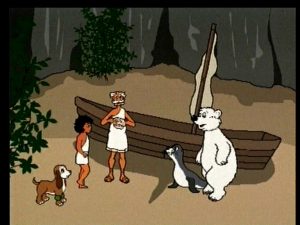 The base of operations.
The base of operations.
On that island they encounter two animals not very common in that region.
 You don’t often see white bear talking in Atlantis story.
You don’t often see white bear talking in Atlantis story.
Actually they mention they got there from Alaska so this must be a nod to Balto cartoon.
Anyway, Petros manages to find Atlantis after exhaustive search and asking everybody (which reminded me a bit of Eco Quest 1 for some reason).
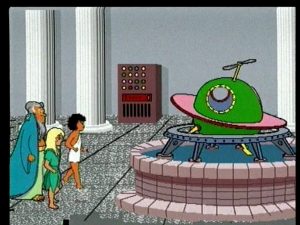 … and strange Atlantean devices.
… and strange Atlantean devices.
And I really should not spoil how it goes from there. Watch it for yourself.
Pocahontas
Another classic story that everybody probably remembers. But if you look closely it’s not just about Pocahontas, it’s about Wabuu in the reverse situation. If you ignore all the interactions between Powhattan tribe and Europeans it’s a story about Wabuu having fun…
 Wabuu is not afraid to try drinks that should not exist yet.
Wabuu is not afraid to try drinks that should not exist yet.
…and meeting a girl from a distant land overseas that stays with him in America at the end.
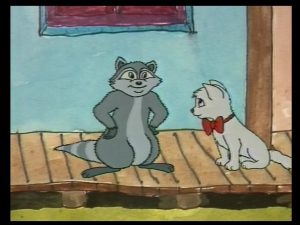 Yup, that’s the true finale here.
Yup, that’s the true finale here.
Also this cartoon features three or four songs including Wabuu title song specially adapted for this setting (he sings about teepees, for example) with a little bird making remarks here and there. Overall, definite must see.
Anastasia
This is yet another fairy tale, in a sense that it has no historical truth in it beside the fact some people mentioned there existed. But for some reason the story of Anastasia escaping execution was popular in the West.
Let’s glance at it a bit:
Moscow was not the capital at that time, the actual capital was St. Peterburg and the residence of Russian Emperor (czar is a title equivalent to king, not emperor BTW) was located there as well.
Rasputin was killed in 1916, the revolutions (in February and October—Old Style) happened in 1917, the palace was not bombed. Instead, the emperor abdicated (in a train in the middle of nowhere) and later he was put under guard, deported to Siberia and shot there with his whole family. In Russia they still have a lot of places named after his executor.
Fun fact: while vodka has been loved and consumed in Russia since centuries, it was more often called “wine”—like “bread wine” or “green wine” or “table wine”. And shops selling it would advertise wine selling.
The word “glasnost” you can see there became popular in 1985 with Perestroika and waned with the end of Perestroika as well. Typical anachronism.
This one might be real though.
Overall, it’s entertaining but I somehow can’t connect with the story, it’s too unrealistic to be true and not enough fantasy to reach the status of classic fairy tale.
Hunchback of Notre Dame
A literary classic well-known everywhere. Though it’s usually lightened up in adaptations because the original is dark and has bad ending (Victor Hugo is not known for cheerful prose after all).
As usual, the story follows the story of Quasimodo, an abandoned child found by clergy and raised to be a bell-ringer in the famous church.
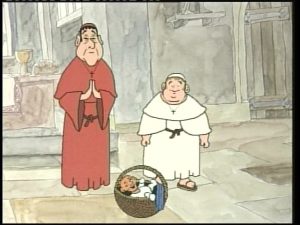 The titular hero is just discovered.
The titular hero is just discovered.
He develops into a not very attractive man and spends his time inside the cathedral ringing bells.
But one day he goes outside, meets new people including Pierre and somehow the story shifts to Pierre and his love interest Esmeralda.
The cartoon ends on not the happiest ending but they tried to follow the original even if they had to soften and lighten it up a bit for children. But mostly it’s worthy to watch for the goat that steals the show.
Unfortunately the next review should be the last one in this series. I’ll put my opinion on all these cartoons there as well, so stay tuned.
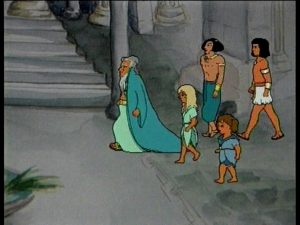 Atlanteans…
Atlanteans…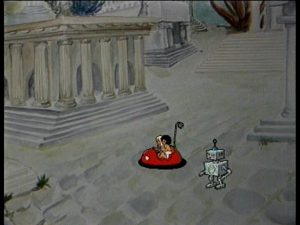 … Atlantis…
… Atlantis…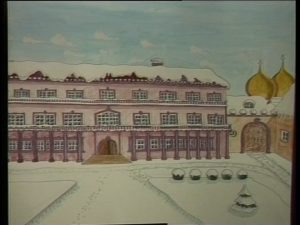 Czar Palace in Moscow.
Czar Palace in Moscow.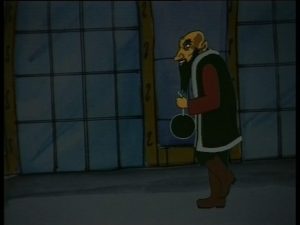 Rasputin bombing the palace.
Rasputin bombing the palace.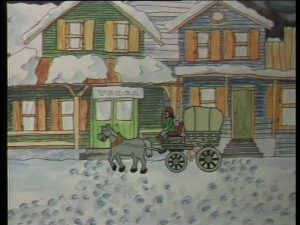 Typical Russian landscape.
Typical Russian landscape. Newspaper
Newspaper French border control.
French border control. He’s all grown up.
He’s all grown up.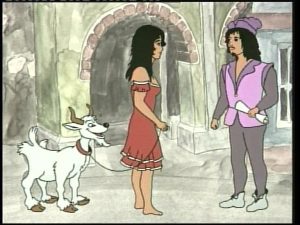 Esmeralda and Pierre
Esmeralda and Pierre